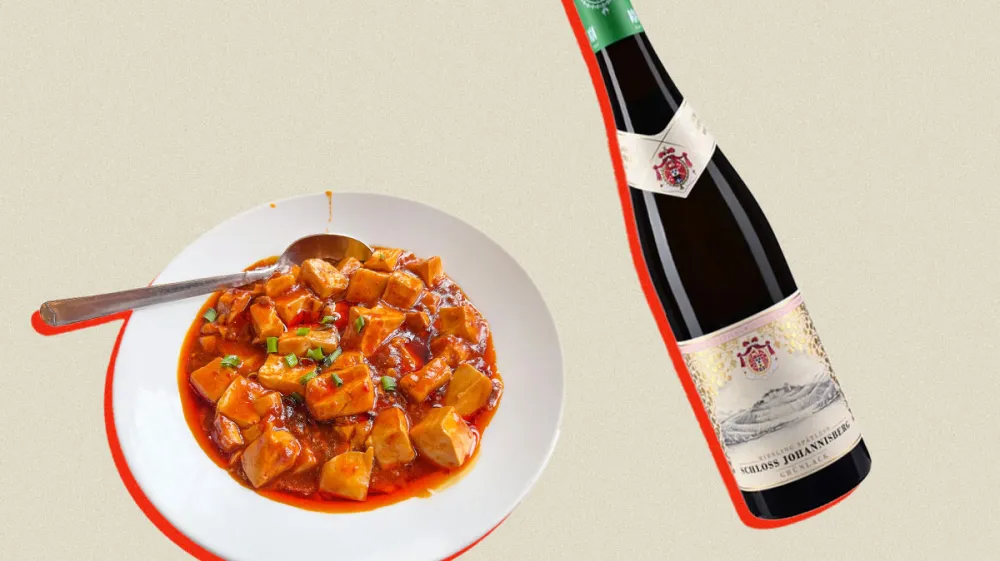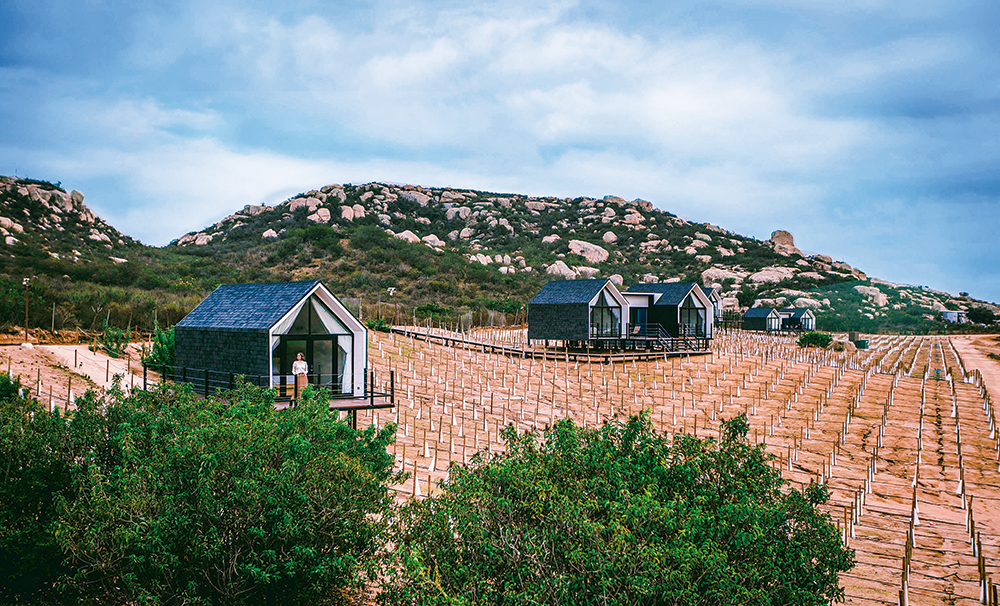
The New Worlds Of Wine
Changing weather and emerging fortunes are conspiring to create promising vineyards in wholly unexpected places. But where will your next bombshell bottle come from?
Related articles
The world of wine has always operated on its own schedule—greatness takes time. It generally requires many seasons for a vineyard to mature to the point at which the vines produce wine with serious ageing potential. In the big picture, some European regions have spent a millennium or more refining the taste profiles of their bottlings.
But the combination of rapidly evolving technology, emerging international economies and the progressing effects of climate change has scrambled the traditional map and fast-forwarded the timeline. There’s now good wine from Virginia, Israel and Brazil, but some countries we know and love—including our very own Australia —have regions that are likely to struggle to continue producing the excellent wine we’re used to because of heat, drought and fires. But amid the chaos some happy surprises, with a number of previously overlooked countries and areas set to ascend.
Georgia
Georgian wine may present the perfect blend of storied past and exciting future. “It’s an ancient tradition, at least 8,000 years old,” says John Wurdeman, an American wunderkind impresario of Georgian grapes. But history isn’t what’s motivating the newest fans in the US. “American hipster wine bars are serving orange wines from there, made in clay pots, to rebel against the status quo Bordeaux and Napa wines they think are boring.” True enough—the bottles are popping up at places like wine bar Ten Bells on New York’s Lower East Side, as well as at the Michelin-starred Washington, D.C., restaurant Maydān.
Wurdeman cofounded Pheasant’s Tears, a boutique natural winery that makes 15 or 16 different bottlings every year. It’s the Georgian winery with perhaps the most US snob appeal, but it’s not alone; wine imports from Georgia to the US almost doubled this past year over 2018. Wurdeman employs the most distinct tradition of the country, fermenting all his wines in qvevri, the traditional clay pots that are buried in the ground.
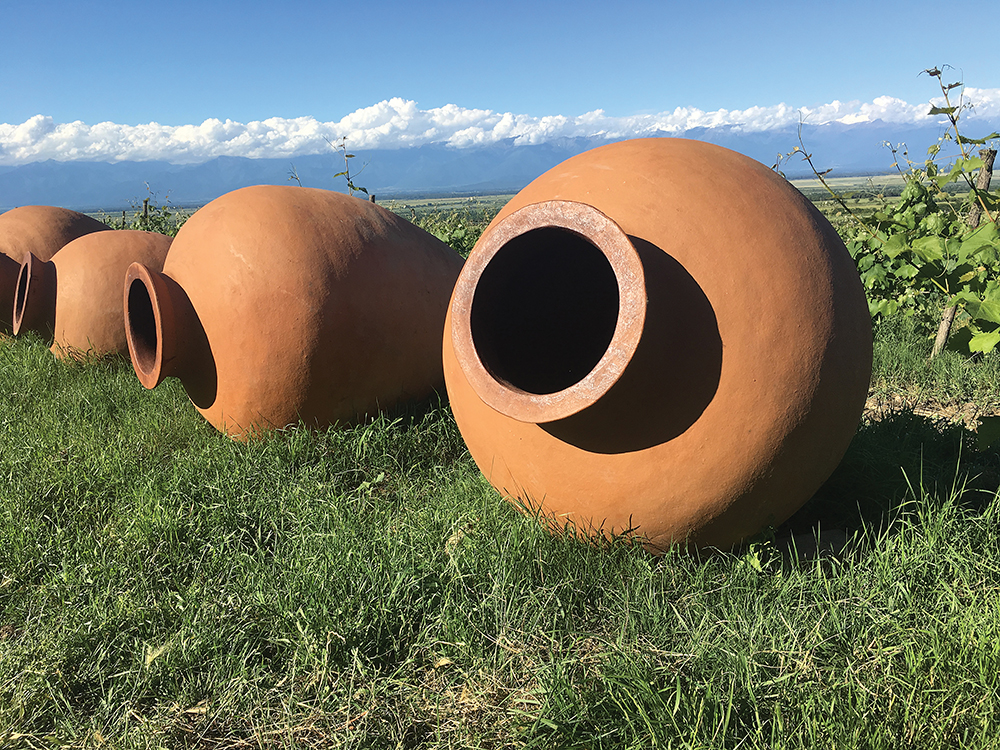
The old ways are part of Georgia’s unique story, but so are modern winemaking techniques—even though it has taken a while to shake off the stagnation of 70 years under Soviet domination, which did no favours for the wine industry.
“It’s not an easy history” is how Wurdeman puts it. Lisa Granik, who holds a prestigious master-of-wine title and wrote a book on Georgian wine, travels there often and says that, slowly, “Georgia is entering the modern world.”
Since the country has some 500 varieties of grapes, you can give up now on getting a handle on the full range of Georgian offerings, but among white, you’ll see Mtsvane, Kisi and Rkatsiteli grapes; among reds, Saperavi, which Granik calls the “Syrah of Georgia.” But, says Wurdeman, “if people try one Georgian wine, it’s often orange, since so many of our grapes lend themselves to that expression.”
His Pheasant’s Tears 2018 Mtsvane Amber Wine is an example of the quirky, intense and appealing style, which more people are discovering. It’s no wonder that Granik says, “In a generation, we’ll see more varieties and better quality. The best Georgian wines are yet to come.”
Valle de Guadalupe, Mexico
In the past five years, the idea of wine from Mexico went from crazy-sounding to very enticing. A mere 110-kilometre drive south of the US-Mexico border on the Baja Peninsula is the Valle de Guadalupe, where some 150 wineries, mostly small operations, have sprouted up to take advantage of wine-friendly conditions. The region produces 90 per cent of the country’s wines.
Most well-established wine regions have rules and customs governing what gets made, but Guadalupe is in a position to experiment and see what works.
“It reminds me of Paso Robles 15 years ago,” says Tomás Bracamontes, who has become a major importer of the wines through his company, La Competencia Imports. “There are no rules. You can do anything you want. Some people are making Pinot Noir and others Rhône blends.” Bracamontes’s money is on the white grape Chenin Blanc as far as up-and-comers go, and “Tempranillo is doing really well,” he adds, referring to Spain’s great red export.
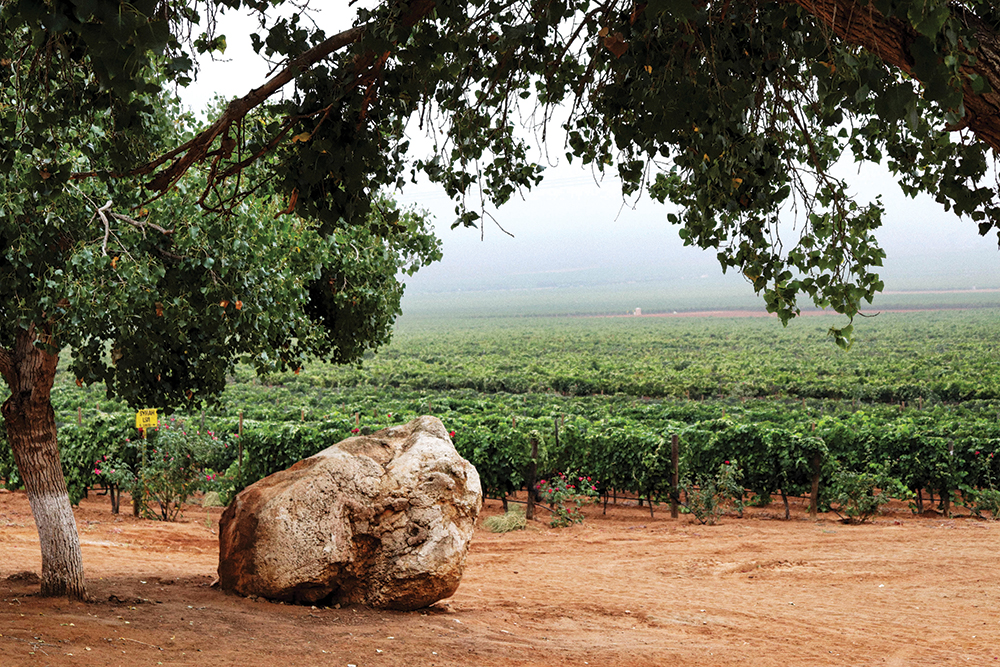
The wineries may be small, but they’ve caught the eye of industry power players. Lourdes Martinez Ojeda became a talked-about winemaker with her work for Bodegas Henri Lurton, a Valle de Guadalupe venture of Bordeaux’s renowned Lurton family (they make Château Brane-Cantenac and many others).
“Having this great Bordeaux family down there has really helped,” says Jeff Harding, the beverage director at the Waverly Inn in New York.
Harding, who visited the region last year, quickly became a fan, putting Guadalupe wines on his list. He compares the climate to some familiar California regions.
“It’s hot in the day, but it’s between two mountain ranges, so it cools right down at night. It’s comparable to Napa.” (Others say the torrid climate of the Priorat area in Spain is closer to the mark.)
Harding’s primary recommendation is about taste: “Bigger, riper fruit” is the overall profile compared to other places. “They’re approachable and great to drink,” he adds, “and it doesn’t hurt that they go great with Mexican food. Without a doubt, we’ll be seeing more of these wines in 20 years.” Keen to try something you won’t get anywhere else? Sample the natural-style bottlings from La Casa Vieja: Made from the original rootstock—some of the vines are 120 years old—the wines are funky, fascinating and distinct.
Okanagan Valley, British Columbia
The emerging Canadian region making the biggest impression on global palates is the Okanagan Valley in British Columbia, the southern portion of which lies just across the border from Washington State. And the valley will be only more influential in the coming years.
It’s a long, skinny area oriented on a north-south axis: In the north, it’s cooler, and Pinot Noir and Riesling grapes thrive; in the south, much hotter and a home to Bordeaux red grapes such as Merlot and Cabernet Sauvignon. “There are so many places that make good Cab, but I loved the Riesling from Martin’s Lane,” says James Tidwell, master sommelier and co-founder of Texsom, an influential conference of sommeliers. “I brought some back from my trip—and I never do that.”
The region’s prime mover is Anthony von Mandl, owner of Martin’s Lane, Mission Hill winery and three other properties that he calls the “Iconic Wineries” of BC. “They’re all managed independently,” says von Mandl, “in the same way LVMH has 75 fashion brands.” Among the best of Mission Hill’s wines is the 2012 Oculus, a silky and rewarding Bordeaux-style blend. Another in von Mandl’s portfolio, CheckMate 2015 Little Pawn Chardonnay, scored 100 points from well-regarded Canadian critic John Schreiner; it also happened to nab the vote of former vice president Al Gore, who ordered two cases before that review was out. The irony of Gore’s connoisseurship does not escape von Mandl: “Little did he know it was enabled by climate change.”

England
Over the past 30 years the bubblies have popped up in various parts of southern England, where climate change has created perfect conditions for making sparkling wine. The vintners explicitly model their businesses after Champagne, planting that region’s three grapes: Chardonnay, Pinot Noir and Pinot Meunier.
Hampshire’s Hambledon Vineyard, founded in 1952 and acquired in 1999 by former investment banker Ian Kellett, started selling sparkling wine in 2014.
“He saw the potential in the chalky soils here, just like in Champagne,” says Hambledon’s education manager, Katrina Smith. She adds that the winery’s bubblies are in a “broader, richer style” than those of similar English wineries, and that all the grapes come from nearby estate vineyards that Hambledon owns, giving the winery more control over the product.
The chief winemaker of another sparkling winery, Nyetimber, cautions against too simplistic a view regarding warming temperatures. “It’s really climate chaos,” states Cherie Spriggs. “In 2012 we didn’t harvest a single grape. It was the coldest conditions since we’ve been keeping records.”
It’s the cooler-than-most conditions that are generally why people like these wines and it helps explain Nyetimber’s elegant drops (its Blanc de Blancs is superb), which have been winning blind tastings against Champagne, which is deeply satisfying for Spriggs: “That’s our benchmark.”
India
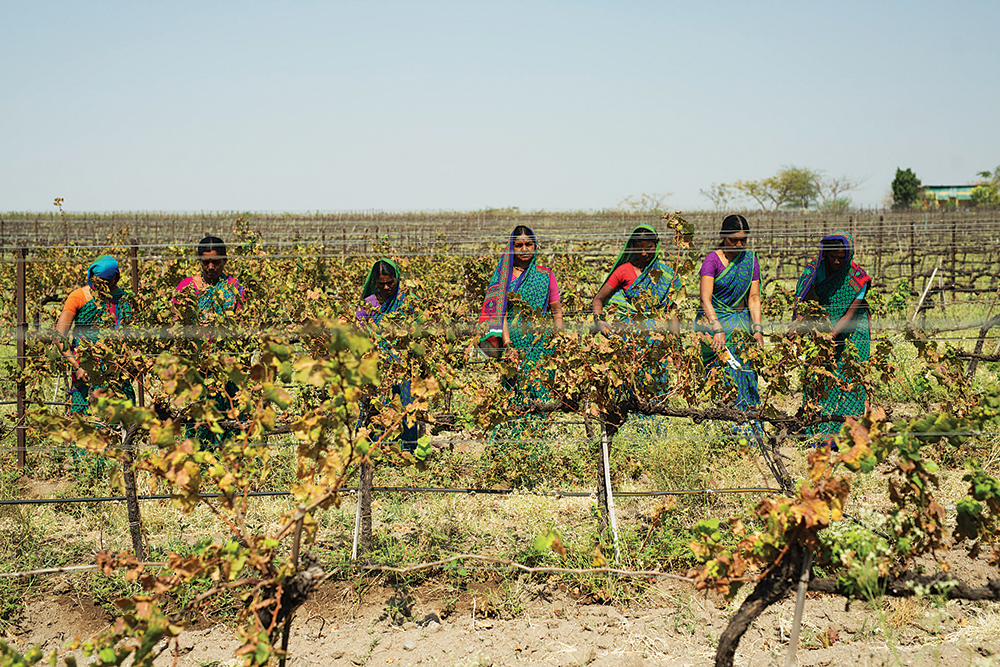
Despite ancient traditions of winemaking, India’s more a beer-and-spirits kind of country. But thanks to some wealthy entrepreneurs, things are starting to happen when it comes to premium wine.
Pharmaceutical tycoons Krishna Prasad and Uma Chigurupati established Krsma Estates in 2008 in Hampi Hills, a hot, dry inland area, which Prasad cheerfully concedes is “not a wine region.” But in his travels he stumbled upon a farmer who was growing wine grapes there and realised how good the conditions were. Krsma now produces three wines a year including a fairly classic Cabernet Sauvignon that’s been commended at international wine competitions. Now making 5,000 cases a year, Prasad notes that his “ego” dictates that the wine be exported too. “It’s a passion and a hobby for me,” he says, “not a business.”
Founder of Fratelli Vineyards’ Sette label, Kapil Sekhri, has similar inspirations. But he’s taken a decidedly cooperative approach: He makes Fratelli’s wines in India, with grapes from the Maharashtra region not too far from Mumbai, but he does it in partnership with Tuscan winemakers Piero Masi and the Secci family. And the wines have been praised by the respected British critic Jancis Robinson.
Sekhri also partners with French-born, Napa-based winemaker and entrepreneur Jean-Charles Boisset, to make three Indian wines under the J’noon label, the best of which is the white, a blend of Chardonnay and Sauvignon Blanc.
This story comes from our latest Autumn 2020 issue. To purchase a copy or to sign up to an annual subscription of Robb Report Australia & New Zealand click here. To stay in touch with all the latest news click here.
Subscribe to the Newsletter
Recommended for you
The Ultimate Guide to Pairing Wine With Spicy Food
What to drink when your favorite cuisine brings the heat.
Here’s What Goes Into Making Jay-Z’s $1,800 Champagne
We put Armand de Brignac Blanc de Noirs Assemblage No. 4 under the microsope.
By Mike Desimone And Jeff Jenssen
April 23, 2024
You may also like.
You may also like.
Watch of the Week: TAG Heuer Formula 1 | Kith
The legendary sports watch returns, but with an unexpected twist.
Over the last few years, watch pundits have predicted the return of the eccentric TAG Heuer Formula 1, in some shape or form. It was all but confirmed when TAG Heuer’s heritage director, Nicholas Biebuyck, teased a slew of vintage models on his Instagram account in the aftermath of last year’s Watches & Wonders 2023 in Geneva. And when speaking with Frédéric Arnault at last year’s trade fair, the former CEO asked me directly if the brand were to relaunch its legacy Formula 1 collection, loved by collectors globally, how should they go about it?
My answer to the baited entreaty definitely didn’t mention a collaboration with Ronnie Fieg of Kith, one of the world’s biggest streetwear fashion labels. Still, here we are: the TAG Heuer Formula 1 is officially back and as colourful as ever.
As the watch industry enters its hype era—in recent years, we’ve seen MoonSwatches, Scuba Fifty Fathoms, and John Mayer G-Shocks—the new Formula 1 x Kith collaboration might be the coolest yet.

Here’s the lowdown: overnight, TAG Heuer, together with Kith, took to socials to unveil a special, limited-edition collection of Formula 1 timepieces, inspired by the original collection from the 1980s. There are 10 new watches, all limited, with some designed on a stainless steel bracelet and some on an upgraded rubber strap; both options nod to the originals.
Seven are exclusive to Kith and its global stores (New York, Los Angeles, Miami, Hawaii, Tokyo, Toronto, and Paris, to be specific), and are made in an abundance of colours. Two are exclusive to TAG Heuer; and one is “shared” between TAG Heuer and Kith—this is a highlight of the collection, in our opinion. A faithful play on the original composite quartz watch from 1986, this model, limited to just 1,350 pieces globally, features the classic black bezel with red accents, a stainless steel bracelet, and that creamy eggshell dial, in all of its vintage-inspired glory. There’s no doubt that this particular model will present as pure nostalgia for those old enough to remember when the original TAG Heuer Formula 1 made its debut.

Of course, throughout the collection, Fieg’s design cues are punctuated: the “TAG” is replaced with “Kith,” forming a contentious new brand name for this specific release, as well as Kith’s slogan, “Just Us.”
Collectors and purists alike will appreciate the dedication to the original Formula 1 collection: features like the 35mm Arnite cases—sourced from the original 80s-era supplier—the form hour hand, a triangle with a dot inside at 12 o’clock, indices that alternate every quarter between shields and dots, and a contrasting minuterie, are all welcomed design specs that make this collaboration so great.
Every TAG Heuer Formula 1 | Kith timepiece will be presented in an eye-catching box that complements the fun and colour theme of Formula 1 but drives home the premium status of this collaboration. On that note, at $2,200 a piece, this isn’t exactly an approachable quartz watch but reflects the exclusive nature of Fieg’s Kith brand and the pieces he designs (largely limited-edition).

So, what do we think? It’s important not to understate the significance of the arrival of the TAG Heuer Formula 1 in 1986, in what would prove integral in setting up the brand for success throughout the 90’s—it was the very first watch collection to have “TAG Heuer” branding, after all—but also in helping to establish a new generation of watch consumer. Like Fieg, many millennial enthusiasts will recall their sentimental ties with the Formula 1, often their first timepiece in their horological journey.
This is as faithful of a reissue as we’ll get from TAG Heuer right now, and budding watch fans should be pleased with the result. To TAG Heuer’s credit, a great deal of research has gone into perfecting and replicating this iconic collection’s proportions, materials, and aesthetic for the modern-day consumer. Sure, it would have been nice to see a full lume dial, a distinguishing feature on some of the original pieces—why this wasn’t done is lost on me—and perhaps a more approachable price point, but there’s no doubt these will become an instant hit in the days to come.
—
The TAG Heuer Formula 1 | Kith collection will be available on Friday, May 3rd, exclusively in-store at select TAG Heuer and Kith locations in Miami, and available starting Monday, May 6th, at select TAG Heuer boutiques, all Kith shops, and online at Kith.com. To see the full collection, visit tagheuer.com
You may also like.
8 Fascinating Facts You Didn’t Know About Aston Martin
The British sports car company is most famous as the vehicle of choice for James Bond, but Aston Martin has an interesting history beyond 007.
Aston Martin will forever be associated with James Bond, ever since everyone’s favourite spy took delivery of his signature silver DB5 in the 1964 film Goldfinger. But there’s a lot more to the history of this famed British sports car brand beyond its association with the fictional British Secret Service agent.
Let’s dive into the long and colourful history of Aston Martin.
You may also like.
What Venice’s New Tourist Tax Means for Your Next Trip
The Italian city will now charge visitors an entry fee during peak season.
Visiting the Floating City just got a bit more expensive.
Venice is officially the first metropolis in the world to start implementing a day-trip fee in an effort to help the Italian hot spot combat overtourism during peak season, The Associated Press reported. The new program, which went into effect, requires travellers to cough up roughly €5 (about $AUD8.50) per person before they can explore the city’s canals and historic sites. Back in January, Venice also announced that starting in June, it would cap the size of tourist groups to 25 people and prohibit loudspeakers in the city centre and the islands of Murano, Burano, and Torcello.
“We need to find a new balance between the tourists and residents,’ Simone Venturini, the city’s top tourism official, told AP News. “We need to safeguard the spaces of the residents, of course, and we need to discourage the arrival of day-trippers on some particular days.”
During this trial phase, the fee only applies to the 29 days deemed the busiest—between April 25 and July 14—and tickets will remain valid from 8:30 am to 4 pm. Visitors under 14 years of age will be allowed in free of charge in addition to guests with hotel reservations. However, the latter must apply online beforehand to request an exemption. Day-trippers can also pre-pay for tickets online via the city’s official tourism site or snap them up in person at the Santa Lucia train station.
“With courage and great humility, we are introducing this system because we want to give a future to Venice and leave this heritage of humanity to future generations,” Venice Mayor Luigi Brugnaro said in a statement on X (formerly known as Twitter) regarding the city’s much-talked-about entry fee.
Despite the mayor’s backing, it’s apparent that residents weren’t totally pleased with the program. The regulation led to protests and riots outside of the train station, The Independent reported. “We are against this measure because it will do nothing to stop overtourism,” resident Cristina Romieri told the outlet. “Moreover, it is such a complex regulation with so many exceptions that it will also be difficult to enforce it.”
While Venice is the first city to carry out the new day-tripper fee, several other European locales have introduced or raised tourist taxes to fend off large crowds and boost the local economy. Most recently, Barcelona increased its city-wide tourist tax. Similarly, you’ll have to pay an extra “climate crisis resilience” tax if you plan on visiting Greece that will fund the country’s disaster recovery projects.
You may also like.
Omega Reveals a New Speedmaster Ahead of the Paris 2024 Olympics
Your first look at the new Speedmaster Chronoscope, designed in the colour theme of the Paris Olympics.
The starters are on the blocks, and with less than 100 days to go until the Paris 2024 Olympics, luxury Swiss watchmaker Omega was bound to release something spectacular to mark its bragging rights as the official timekeeper for the Summer Games. Enter the new 43mm Speedmaster Chronoscope, available in new colourways—gold, black, and white—in line with the colour theme of the Olympic Games in Paris this July.
So, what do we get in this nicely-wrapped, Olympics-inspired package? Technically, there are four new podium-worthy iterations of the iconic Speedmaster.

The new versions present handsomely in stainless steel or 18K Moonshine Gold—the brand’s proprietary yellow gold known for its enduring shine. The steel version has an anodised aluminium bezel and a stainless steel bracelet or vintage-inspired perforated leather strap. The Moonshine Gold iteration boasts a ceramic bezel; it will most likely appease Speedy collectors, particularly those with an affinity for Omega’s long-standing role as stewards of the Olympic Games.
Notably, each watch bears an attractive white opaline dial; the background to three dark grey timing scales in a 1940s “snail” design. Of course, this Speedmaster Chronoscope is special in its own right. For the most part, the overall look of the Speedmaster has remained true to its 1957 origins. This Speedmaster, however, adopts Omega’s Chronoscope design from 2021, including the storied tachymeter scale, along with a telemeter, and pulsometer scale—essentially, three different measurements on the wrist.
While the technical nature of this timepiece won’t interest some, others will revel in its theatrics. Turn over each timepiece, and instead of a transparent crystal caseback, there is a stamped medallion featuring a mirror-polished Paris 2024 logo, along with “Paris 2024” and the Olympic Rings—a subtle nod to this year’s games.
Powering this Olympiad offering—and ensuring the greatest level of accuracy—is the Co-Axial Master Chronometer Calibre 9908 and 9909, certified by METAS.

A Speedmaster to commemorate the Olympic Games was as sure a bet as Mondo Deplantis winning gold in the men’s pole vault—especially after Omega revealed its Olympic-edition Seamaster Diver 300m “Paris 2024” last year—but they delivered a great addition to the legacy collection, without gimmickry.
However, the all-gold Speedmaster is 85K at the top end of the scale, which is a lot of money for a watch of this stature. By comparison, the immaculate Speedmaster Moonshine gold with a sun-brushed green PVD “step” dial is 15K cheaper, albeit without the Chronoscope complications.
—
The Omega Speedmaster Chronoscope in stainless steel with a leather strap is priced at $15,725; stainless steel with steel bracelet at $16,275; 18k Moonshine Gold on leather strap $54,325; and 18k Moonshine Gold with matching gold bracelet $85,350, available at Omega boutiques now.
Discover the collection here
You may also like.
Here’s What Goes Into Making Jay-Z’s $1,800 Champagne
We put Armand de Brignac Blanc de Noirs Assemblage No. 4 under the microsope.
In our quest to locate the most exclusive and exciting wines for our readers, we usually ask the question, “How many bottles of this were made?” Often, we get a general response based on an annual average, although many Champagne houses simply respond, “We do not wish to communicate our quantities.” As far as we’re concerned, that’s pretty much like pleading the Fifth on the witness stand; yes, you’re not incriminating yourself, but anyone paying attention knows you’re probably guilty of something. In the case of some Champagne houses, that something is making a whole lot of bottles—millions of them—while creating an illusion of rarity.
We received the exact opposite reply regarding Armand de Brignac Blanc de Noirs Assemblage No. 4. Yasmin Allen, the company’s president and CEO, told us only 7,328 bottles would be released of this Pinot Noir offering. It’s good to know that with a sticker price of around $1,800, it’s highly limited, but it still makes one wonder what’s so exceptional about it.
Known by its nickname, Ace of Spades, for its distinctive and decorative metallic packaging, Armand de Brignac is owned by Louis Vuitton Moët Hennessy and Jay-Z and is produced by Champagne Cattier. Each bottle of Assemblage No. 4 is numbered; a small plate on the back reads “Assemblage Four, [X,XXX]/7,328, Disgorged: 20 April, 2023.” Prior to disgorgement, it spent seven years in the bottle on lees after primary fermentation mostly in stainless steel with a small amount in concrete. That’s the longest of the house’s Champagnes spent on the lees, but Allen says the winemaking team tasted along the way and would have disgorged earlier than planned if they’d felt the time was right.
Chef de cave, Alexandre Cattier, says the wine is sourced from some of the best Premier and Grand Cru Pinot Noir–producing villages in the Champagne region, including Chigny-les-Roses, Verzenay, Rilly-la-Montagne, Verzy, Ludes, Mailly-Champagne, and Ville-sur-Arce in the Aube département. This is considered a multi-vintage expression, using wine from a consecutive trio of vintages—2013, 2014, and 2015—to create an “intense and rich” blend. Seventy percent of the offering is from 2015 (hailed as one of the finest vintages in recent memory), with 15 percent each from the other two years.

This precisely crafted Champagne uses only the tête de cuvée juice, a highly selective extraction process. As Allen points out, “the winemakers solely take the first and freshest portion of the gentle cuvée grape press,” which assures that the finished wine will be the highest quality. Armand de Brignac used grapes from various sites and three different vintages so the final product would reflect the house signature style. This is the fourth release in a series that began with Assemblage No. 1. “Testing different levels of intensity of aromas with the balance of red and dark fruits has been a guiding principle between the Blanc de Noirs that followed,” Allen explains.
The CEO recommends allowing the Assemblage No. 4 to linger in your glass for a while, telling us, “Your palette will go on a journey, evolving from one incredible aroma to the next as the wine warms in your glass where it will open up to an extraordinary length.” We found it to have a gorgeous bouquet of raspberry and Mission fig with hints of river rock; as it opened, notes of toasted almond and just-baked brioche became noticeable. With striking acidity and a vein of minerality, it has luscious nectarine, passion fruit, candied orange peel, and red plum flavors with touches of beeswax and a whiff of baking spices on the enduring finish. We enjoyed our bottle with a roast chicken rubbed with butter and herbes de Provence and savored the final, extremely rare sip with a bit of Stilton. Unfortunately, the pairing possibilities are not infinite with this release; there are only 7,327 more ways to enjoy yours.






